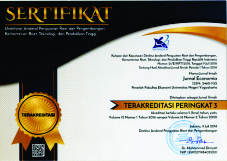Antecedents and Consequences of Brand Love with Moderated By Memories
Downloads
Abstract
This research aims to examine the effect of perceived brand quality and brand personality on brand fondness with memories as moderator. This study examines the effect of independent variables on dependent variable with memories as moderating variable. The subject in this research were students, civil servants, professionals (nuns, accountants), entrepreneurs, private employees whom are users of Asus brand laptop in Indonesia. The sample were chosen by using nonprobability sampling technique namely purposive sampling. The instrument of this study was online questionnaire and the gathered data is analyzed by using multiple regression analysis. The finding of this study explains that perceived brand quality and brand personality have a positive effect on brand fondness. Brand fondness has a positive effect on brand loyalty and active engagement. The finding on moderation variables explains that memories are not proven to moderate the effect between perceived brand quality and brand fondness, it means that the magnitude of memory as a moderating variable has nothing to do with the relationship between independent variables and dependent variable. In addition, the finding of variable memories proved to moderate the effect between brand personality and brand fondness, it means that it will strongly influence the relationship between brand personality and brand fondness when the variable memory is high, otherwise it will become weak when the variable memory is low.
Keywords: Perceived brand quality, brand personality, brand love, brand loyalty, active engagement, memories.
Anteseden dan Konsekuensi Kecintaan Merek dengan Dimoderasi oleh KenanganAbstrak
Penelitian ini bertujuan untuk menguji pengaruh kualitas merek yang dipersepsikan dan kepribadian merek pada kecintaan merek dengan kenangan sebagai pemoderasi. Subjek dalam penelitian ini adalah mahasiswa, PNS, profesional (suster, akuntan), wiraswasta, karyawan swasta yang merupakan pengguna laptop merek Asus di Indoensia. Sampel yang dipilih menggunakan teknik nonprobability sampling dengan jenis purposive sampling. Instrumen penelitian ini adalah kuesioner yang dibuat secara online dan dianalisis dengan analisis regresi berganda. Penelitian ini menemukan bahwa kualitas merek yang dipersepsikan dan kepribadian merek memiliki pengaruh positif pada kecintaan merek. Kecintaan merek memiliki pengaruh positif pada loyalitas merek dan keterlibatan aktif. Temuan pada variabel moderasi, kenangan tidak terbukti memoderasi pengaruh antara kualitas merek yang dipersepsikan dan kecintaan merek, artinya bahwa tinggi atau rendahnya kenangan sebagai variabel moderasi tidak ada kaitannya pada hubungan antara variabel independen dan variabel dependen. Selain itu, temuan variabel kenangan terbukti memoderasi pengaruh antara kepribadian merek dan kecintaan merek, artinya bahwa akan menjadi kuat pengaruh kepribadian merek pada kecintaan merek ketika variabel kenangan tinggi, dan sebaliknya akan menjadi lemah ketika variabel kenangan rendah.
Kata kunci: Kualitas merek yang dipersepsikan, kepribadian merek, kecintaan merek, loyalitas merek, keterlibatan aktif, kenangan positif.
Downloads
Aaker, J. L., & Maheswaran, D. (1997). New directions in cultural psychology: The effects of cultural orientation on affect and cognition. Advances in Consumer Research, 24(1), 244. https://doi.org/dx.doi.org/10.1037/pag0000101
Ahuvia, A., Bagozzi, R. P., & Batra, R. (2014). Psychometric vs. C-OAR-SE measures of brand love: A reply to Rossiter. Marketing Letters, 25(2), 235–243. https://doi.org/10.1007/s11002-013-9251-4
Ahuvia, A. C. (2005). Beyond the Extended Self: Loved Objects and Consumers' Identity Narratives. Journal of Consumer Research, 32(1), 171–184. https://doi.org/10.1086/429607
Albert, N., & Merunka, D. (2013). The role of brand love in consumer-brand relationships. Journal of Consumer Marketing. https://doi.org/10.1108/07363761311328928
Albert, N., Merunka, D., & Valette-Florence, P. (2008). When consumers love their brands: Exploring the concept and its dimensions. Journal of Business Research, 61(10), 1062–1075. https://doi.org/10.1016/j.jbusres.2007.09.014
Albert, N., Merunka, D., & Valette-Florence, P. (2013). Brand passion: Antecedents and consequences. Journal of Business Research. https://doi.org/10.1016/j.jbusres.2011.12.009
Albert, N., Wesford, F., Merunka, D., & Valette, P. (2009). ASSOCIATION FOR CONSUMER RESEARCH The Feeling of Love Toward a Brand: Concept and Measurement. Ann L. McGill and Sharon Shavitt, 36, 300–307. Retrieved from http://www.acrwebsite.org/volumes/14537/volumes/v36/NA-36
Baron, R. M., & Kenny, D. A. (1986). Revista Mexicana de Biodiversidad Registro actual del jaguar Panthera onca ( Carnivora : Felidae ) en el Parque. Journal of Pesonality and Social Psychology, 51(6), 1173–1182. https://doi.org/10.1016/j.rmb.2016.01.023
Batra, R., Ahuvia, A., & Bagozzi, R. P. (2012). Brand Love. Journal of Marketing, 76(2), 1–16. https://doi.org/10.1509/jm.09.0339
Bauer, H. H. (University of M., Heinrich, D. (Univeristy of M., & Albrecht, C.-M. (University of M. (2009). All You Need Is Love : Assessing Consumers ' Brand Love. Proceedings of the American Marketing Association Summer Educators Conference, 15(2), 252–253. https://doi.org/10.1145/2395131.2395137
Becheur, I., Bayarassou, O., & Ghrib, H. (2017). Beyond Brand Personality: Building Consumer–Brand Emotional Relationship. Global Business Review, 18(3_suppl), S128–S144. https://doi.org/10.1177/0972150917693160
Belk, R. (1988). Possession and extended self. The Journal of Consumer Research, 15(2), 139–168. https://doi.org/10.1086/209154
Bergkvist, L., & Bech-Larsen, T. (2010). Two studies of consequences and actionable antecedents of brand love. Journal of Brand Management, 17(7), 504–518. https://doi.org/10.1057/bm.2010.6
Bowlby, J. (1969). Attachment and loss, vol. 1: Attachment (Vol. 1). https://doi.org/10.1177/000306518403200125
Carroll, B. A., & Ahuvia, A. C. (2006). Some antecedents and outcomes of brand love. Marketing Letters, 17(2), 79–89. https://doi.org/10.1007/s11002-006-4219-2
Chandy, R., & Tellis, G. (1998). Organizing for Radical Product Innovation : The Overlooked Role of Willingness to Cannibalize Author ( s ): Rajesh K . Chandy and Gerard J . Tellis Source : Journal of Marketing Research , Vol . 35 , No . 4 ( Nov ., 1998 ), pp . 474-487 Published by : Ame. Journal of Marketing Research, 35(4), 474–487. Retrieved from http://www.jstor.org/stable/10.2307/3152166
Chaudhuri, A., & Holbrook, M. B. (2001). The Chain of Effects from Brand Trust and Brand Affect to Brand Performance: The Role of Brand Loyalty. Journal of Marketing, 65(2), 81–93. https://doi.org/10.1509/jmkg.65.2.81.18255
Cooper, D.R, and Schindler, P.S. (2006). Metode Riset Bisnis (9th Edition). New York: McGraw-Hill, PT Media Global Edukasi.
Cooper, D.R, and Schindler, P.S. (2014). Business Research Method (12th Edition). New York: McGraw-Hill.
Dodds, W. B., Monroe, K. B., & Grewal, D. (1991). Effects of Price, Brand, and Store Information on Buyers' Product Evaluations. Journal of Marketing Research, 28(3), 307–319. https://doi.org/10.2307/3172866
Doyle, P. (1990). Building Successful Brands: The Strategic Options. Journal of Consumer Marketing, 7(2), 5–20. https://doi.org/10.1016/b978-0-7506-4479-2.50009-9
Drennan, J., Bianchi, C., Cacho-Elizondo, S., Louriero, S., Guibert, N., & Proud, W. (2015). Examining the role of wine brand love on brand loyalty: A multi-country comparison. International Journal of Hospitality Management, 49, 47–55. https://doi.org/10.1016/j.ijhm.2015.04.012
Fetscherin, M., Boulanger, M., Filho, C. G., & Souki, G. Q. (2014). The effect of product category on consumer brand relationships. Journal of Product and Brand Management, 23(2), 78–89. https://doi.org/10.1108/JPBM-05-2013-0310
Fournier, S. (1998). Consumers and Their Brands: Developing Relationship Theory in Consumer Research. Journal of Consumer Research, 24(4), 343–353. https://doi.org/10.1086/209515
Ghozali, I. (2011). Aplikasi Analisis Multivariate dengan Program IBM SPSS 21 Update PLS Regresi ( Edisi 5), Semarang: Badan Penerbit Universitas Diponegoro.
Grisaffe, D. B., & Nguyen, H. P. (2011). Antecedents of emotional attachment to brands. Journal of Business Research, 64(10), 1052–1059. https://doi.org/10.1016/j.jbusres.2010.11.002
Hair, J. F., Black, W. C., Babin, B. J., & Anderson, R. E. (2010). Overview of Multivariate Methods, 7th Edition.
Huber, F., Meyer, F., & Schmid, D. . (2015). Brand love in progress – the interdependence of brand love antecedents in consideration of relationship duration. Journal of Product & Brand Management Relationships, (6). https://doi.org/10.1108/10610421211215517
Hwang, J., & Kandampully, J. (2012). The role of emotional aspects in younger consumer-brand relationships. Journal of Product and Brand Management. https://doi.org/10.1108/10610421211215517
Ismail, A. R., & Spinelli, G. (2012). Effects of brand love, personality and image on word of mouth: The case of fashion brands among young consumers. Journal of Fashion Marketing and Management: An International Journal, 16(4), 386–398. https://doi.org/10.1108/13612021211265791
Karjaluoto, H., Munnukka, J., & Kiuru, K. (2016). Brand love and positive word of mouth: the moderating effects of experience and price. Journal of Product and Brand Management, 25(6), 527–537. https://doi.org/10.1108/JPBM-03-2015-0834
Kaufmann, H. R., Loureiro, S. M. C., Basile, G., & Vrontis, D. (2012). The increasing dynamics between consumers, social groups and brands. Qualitative Market Research, 15(4), 404–419. https://doi.org/10.1108/13522751211257088
Kaufmann, H. R., Petrovici, D. A., Filho, C. G., & Ayres, A. (2016). Identifying moderators of brand attachment for driving customer purchase intention of original vs counterfeits of luxury brands. Journal of Business Research, 69(12), 5735–5747. https://doi.org/10.1016/j.jbusres.2016.05.003
Keller, K. L. (2013). Strategic Brand Management Building, Measuring, and Managing Brand Equity. In Global Edition (4th ed.). Pearson Education, Inc. https://doi.org/10.1057/bm.1998.36
Kleine, S. S., Kleine, R. E. K., & Allen, C. T. (1995). How is a Possession "Me" or "Not Me"? Characterizing Types and an Antecedent of Material Possession Attachment. Journal of Consumer Research, 22(3), 327. https://doi.org/10.1086/209454
Konecnik, M., & Gartner, W. C. (2007). Customer-based brand equity for a destination. Annals of Tourism Research. https://doi.org/10.1016/j.annals.2006.10.005
Kotler, P., & Keller, K. (2012). Marketing management (14th ed.) Prentice-Hall, Upper Saddle River, NJ.
Louis, D., & Lombart, C. (2010). Impact of brand personality on three major relational consequences (trust, attachment, and commitment to the brand). Journal of Product and Brand Management. https://doi.org/10.1108/10610421011033467
Milewicz, J., & Herbig, P. (1994). Evaluating the Brand Extension Decision Using a Model of Reputation Building. Journal of Product & Brand Management. https://doi.org/10.1108/10610429410053077
Mugge, R., Schifferstein, H. N. J., & Schoormans, J. P. L. (2006). A Longitudinal Study of Product Attachment and its Determinants. European Advances in Consumer Research, 7(April 2015), 641–647.
Mugge, R., Schifferstein, H. N. J., & Schoormans, J. P. L. (2010). Product attachment and satisfaction: Understanding consumers' post-purchase behavior. Journal of Consumer Marketing, 27(3), 271–282. https://doi.org/10.1108/07363761011038347
Neuman, W. Lawrence. (2013). Metode Penelitian Sosials: Pendekatan Kualitatif dan Kuantitatif (Edisi 7). Jakarta: PT Indeks.
Nunnaly,J. and Bernstein, IH. (1994). Psychometric Theory. New York. McGraw-Hill.
Oliver, R. L. (1999). Whence Consumer Loyalty? Journal of Marketing, 63(1999), 33–34. https://doi.org/10.2307/1252099
Park, C. W., MacInnis, D. J., & Priester, J. (2006). Brand Attachment: Constructs, Consequences, and Causes. Foundations and Trends® in Marketing, 1(3), 191–230. https://doi.org/10.1561/1700000006
Rahman, A.F (2017). Notebook Masih Punya Peluang di Indonesia. DetikInet. Diakses dari https://inet.detik.com/consumer/d-3398589/notebook-masih-punya-peluang-di-indonesia pada tanggal 4 April 2017.
Razdan, R. Das, M., and Sohoni, A. (2014). Business Functions Marketing and Sales Ourinsights The Evolving Indonesian Consumer. Di akses dari http://www.mckinsey.com/business-functions/marketing-and-sales/ourinsights-the-evolving-indonesian-consumer pada tanggal 4 April 2017.
Rauschnabel, P. A., & Ahuvia, A. C. (2014). You're so lovable: Anthropomorphism and brand love. Journal of Brand Management, 21(5), 372–395. https://doi.org/10.1057/bm.2014.14
Rossiter, J. R. (2012). A new C-OAR-SE-based content-valid and predictively valid measure that distinguishes brand love from brand liking. Marketing Letters, 23(3), 905–916. https://doi.org/10.1007/s11002-012-9173-6
Roy, S. K., Eshghi, A., & Sarkar, A. (2012). Antecedents and consequences of brand love. Journal of Brand Management, 20(4), 325–332. https://doi.org/10.1057/bm.2012.24
Sarkar, A., & Sreejesh, S. (2014). Examination of the roles played by brand love and jealousy in shaping customer engagement. Journal of Product and Brand Management, 23(1), 24–32. https://doi.org/10.1108/JPBM-05-2013-0315
Schifferstein, H. N. J., & Zwartkruis-Pelgrim, E. P. H. (2008). Consumer-product attachment: Measurement and design implications. International Journal of Design. https://doi.org/10.1108/07363761011038347
Schiffman, Leon G and Leslie, Kanuk, K. (2010). Consumer Behavior (Tenth Edition). Pearson Education.
Spinelli, G., & Ismail, A. R. (2012). Effects of brand love, personality and image on word of mouth. Journal of Fashion Marketing and Management, 11(4), 571–586. https://doi.org/10.1108/03090560410539302
Sternberg, R. J. (1986). A triangular theory of creativity. Psychological Review, 93(2), 119–135. https://doi.org/10.1037/aca0000095
Unal, S., & Aydın, H. (2013). An Investigation on the Evaluation of the Factors Affecting Brand Love. Procedia - Social and Behavioral Sciences, 92(April 2016), 76–85. https://doi.org/10.1016/j.sbspro.2013.08.640
Vernuccio, M., Pagani, M., Barbarossa, C., & Pastore, A. (2015). Antecedents of brand love in online network-based communities. A social identity perspective. Journal of Product and Brand Management. https://doi.org/10.1108/JPBM-12-2014-0772
Wallace, E., Buil, I., & de Chernatony, L. (2014). Consumer engagement with self-expressive brands: Brand love and WOM outcomes. Journal of Product and Brand Management. https://doi.org/10.1108/JPBM-06-2013-0326
Wallendorf, M., Arnould, E. J., & Arnould, E. J. (1988). and Social Linkage Linked references are available on JSTOR for this article : " My Favorite Things ": A Cross-Cultural Inquiry into Object Attachment , Possessiveness , and Social Linkage. Journal of Consumer Research, 14(4), 531–547.
Widiartanto, Y. H. (2017). Asus Klaim Kuasai Pasar Laptop Indonesia. Kompas. Diakses dari Http://tekno.kompas.com/read/2017/03/15/16483787/asus.klaim.kuasai.pasar.laptop.indonesi pada tanggal 4 April 2017.
White, H. (2007). Problem-Based Learning in Introductory Science Across Disciplines. Diakses dari http://www.udel.edu/chem/white/finalrpt.html pada tanggal 6 Januari 2011.
Yang, D. (2010). The effect of perceived quality and value in brand love. 2010 International Conference on Management and Service Science, MASS 2010, 0–2. https://doi.org/10.1109/ICMSS.2010.5577615
Https://news.hargatop.com/2016/01/04/2016-mea-dimulai-pengertian-apa-itu-mea-masih-banyak-masyarakat-indonesia-yang-tidak-mengerti/4119821.html. Diakses pada tanggal 4 April 2017















